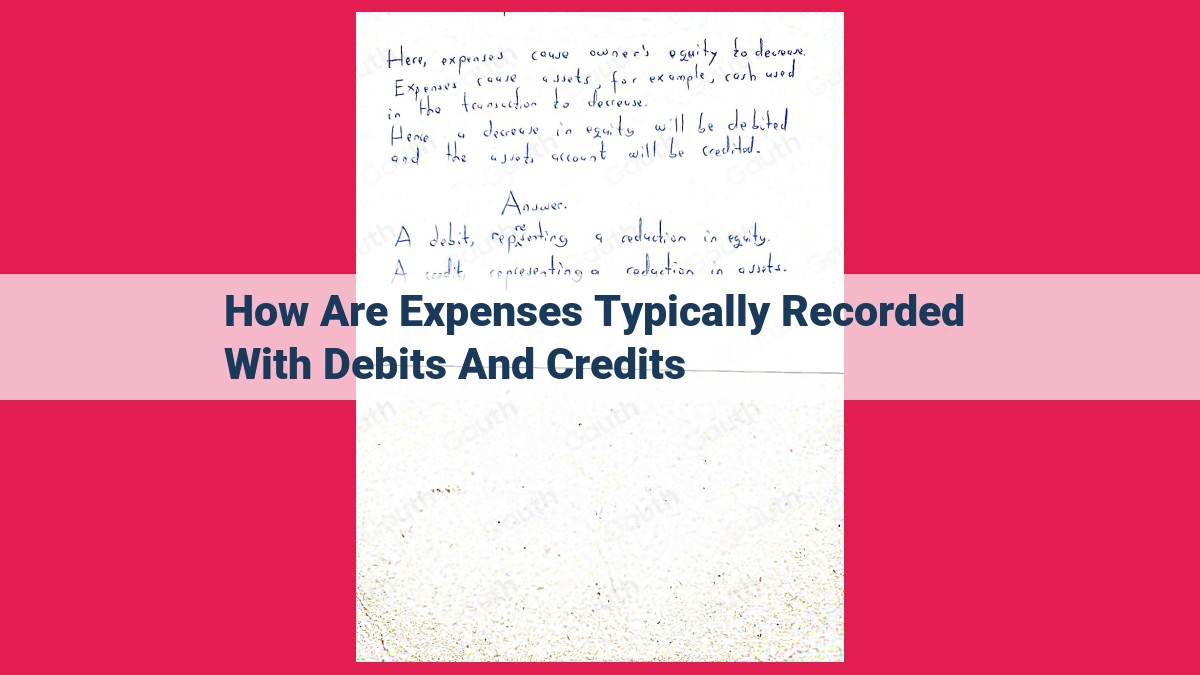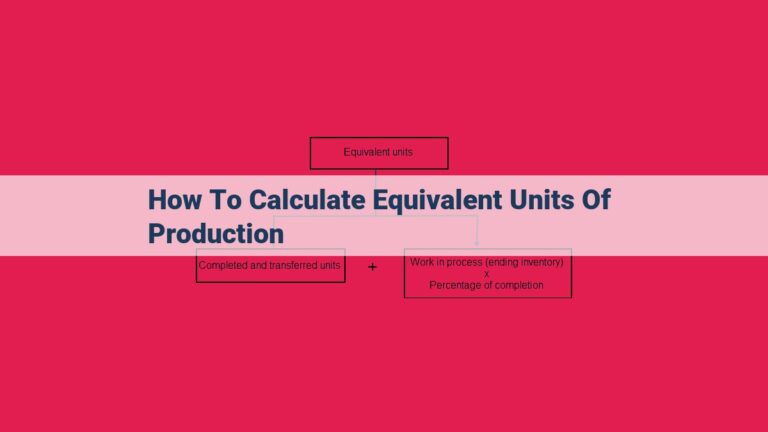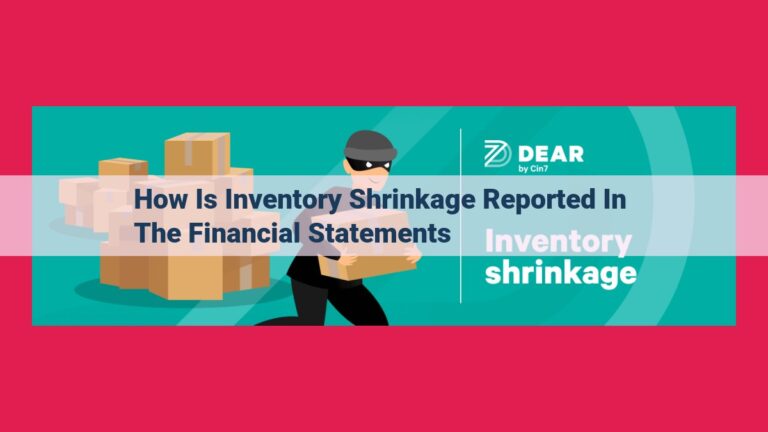Understanding Debits And Credits: Essential For Expense Recording In Accounting

Expenses are typically recorded in accounting using debits and credits. Debits increase expense accounts, indicating an increase in the cost or loss incurred. Credits decrease cash accounts, signifying the outflow of cash used to pay for the expense. The interplay between debits and credits ensures the balancing of accounting entries. For instance, when an expense is incurred, the expense account is debited, and the cash account is credited, reflecting the decrease in cash resources. This process ensures accurate financial record-keeping and provides insights into the expenses incurred by a business.
Understanding Debits and Credits in Expense Recording
In the realm of accounting, the concepts of debits and credits are essential for accurately recording financial transactions. When it comes to expenses, grasping these concepts is crucial for maintaining a clear and organized financial picture.
Debits and Credits: A Balancing Act
In accounting, every transaction involves two entries, one on the debit side and one on the credit side. Debits represent increases in assets, expenses, or losses, while credits indicate increases in liabilities, revenues, or gains. This delicate balancing act ensures that the accounting equation (Assets = Liabilities + Owner’s Equity) always remains in equilibrium.
Expenses and Debits
Expenses represent costs incurred in the course of generating revenue. When an expense is incurred, it is recorded with a debit to the appropriate expense account. For instance, if a company spends money on rent, the expense would be debited to the “Rent Expense” account.
Credits and Cash Accounts
Cash accounts are used to track inflows and outflows of cash. When an expense is paid in cash, the transaction is recorded with a credit to the cash account. This credit represents the decrease in cash resulting from the expense payment.
The Interplay of Debits and Credits
When an expense is recorded, the debit to the expense account and the credit to the cash account balance each other out. This ensures that the accounting equation remains in balance. The debit increases the expense balance, recognizing the cost incurred, while the credit decreases the cash balance, reflecting the payment made.
Example of Expense Recording
Let’s consider an example to illustrate the process. Suppose a company pays $500 for office supplies. The transaction would be recorded as follows:
- Debit: Office Supplies Expense $500
- Credit: Cash $500
This entry increases the Office Supplies Expense account by $500, reflecting the cost incurred, and reduces the Cash account by $500, showing the cash outflow.
Understanding debits and credits is paramount for accurate and effective expense recording. By adhering to these accounting principles, businesses can ensure that their financial records provide a clear and reliable representation of their financial activities.
Debits and Expenses: Unraveling the Accounting Alphabet
In the intricate language of accounting, debits and credits play a crucial role in recording financial transactions. When it comes to expenses, understanding these fundamental concepts is paramount.
Debits: An Accountant’s Thermometer
Debits, akin to a financial thermometer, have the power to increase assets, expenses, or losses. This upward movement signifies the inflow or accumulation of assets or the occurrence of expenses and losses. When an expense is incurred, such as rent or utilities, it’s recorded with a debit to an expense account.
Expense Accounts: The Home for Expenses
Expense accounts are the designated ledgers where expenses find their residence. Each type of expense, from salaries to advertising, has its own dedicated account. When an expense occurs, a debit is made to the relevant expense account, documenting the increase in expenses.
Example: Rent Expense
Imagine you rent a quaint office space for your business. The amount you pay for rent is an expense, which is recorded as follows:
**Debit:** Rent Expense <$500>
This debit increases the Rent Expense account, reflecting the $500 expense incurred.
Credits and Cash Accounts
When it comes to accounting, understanding the concept of credits is just as crucial as understanding debits. Credits play a significant role in increasing your liabilities, revenue, or gains. Just like debits have their designated expense accounts, credits have accounts that they directly impact, and one of the most important ones is the cash account.
Cash accounts are used to meticulously record all cash flow activities, both incoming and outgoing. When you incur an expense that requires immediate payment, the amount paid is recorded with a credit to the cash account. This process ensures that your cash balance is accurately reflected in your accounting records.
To simplify the concept, let’s say you buy office supplies worth $500 and pay for them in cash. The accounting entry for this transaction would look something like this:
Debit: Expense Account (Office Supplies) $500
Credit: Cash Account $500
By debiting the expense account, you’re recognizing the increase in your expenses. And by crediting the cash account, you’re recording the decrease in your cash balance due to the payment.
The interplay between debits and credits in expense recording is a fundamental principle of accounting. It’s like a seesaw: when one side goes up (debit), the other side goes down (credit). This ensures that your accounting entries are balanced and compliant with accounting standards.
The Interplay of Debits and Credits in Expense Recording
When it comes to recording expenses, the world of accounting revolves around two fundamental concepts: debits and credits. Understanding how these work together is crucial for ensuring the accuracy of your financial records.
Balancing Act of Debits and Credits
In accounting, debits and credits always balance each other out. They play the role of opposite forces, ensuring that the accounting equation (Assets = Liabilities + Equity) remains in equilibrium. When we debit an account, we add to it. When we credit an account, we subtract from it.
Recording Expenses: The Debit-Credit Dance
When you debit an expense account, you are effectively increasing its balance. This reflects the fact that an expense is a decrease in company assets or an increase in liabilities. Conversely, when you credit a cash account, you are decreasing its balance, reflecting the outflow of cash to pay for the expense.
For instance, consider a business that pays $1,000 for rent. To record this transaction, we would debit the Rent Expense account (an expense account) for $1,000 and credit the Cash account (a cash account) for $1,000.
This entry maintains the accounting equation:
- Assets (Cash) – $1,000
- Liabilities and Equity (Rent Expense) + $1,000
The debit to Rent Expense increases the expense balance, while the credit to Cash reduces the cash balance, showing that the expense was paid using cash.
By understanding the interplay between debits and credits, you can accurately record expenses and ensure the integrity of your financial records. Remember, debits increase expenses, while credits reflect cash outflows. This accounting dance is essential for maintaining the balance and accuracy of your financial statements.
Example of Recording an Expense
Scenario:
Imagine you’re the owner of “Cozy Cafe,” a quaint establishment that serves delectable coffee and pastries. On a bustling Saturday morning, you purchase $50 worth of coffee beans to replenish your dwindling supply. How do you accurately record this expense in your accounting records?
Recording the Expense:
1. Identify the Expense Account:
Expenses are typically recorded in expense accounts. For your coffee bean purchase, the appropriate expense account is “Coffee Beans Expense.”
2. Debit the Expense Account:
Debits increase expenses. To record the $50 coffee bean purchase, you debit the Coffee Beans Expense account for $50. This signifies an increase in your expenses.
3. Credit the Cash Account:
Expenses are often paid with cash. Since you purchased the coffee beans with cash, you credit the Cash account for $50. This reflects a decrease in your cash balance.
Accounting Entry:
Debit: Coffee Beans Expense $50
Credit: Cash $50
By debiting the Coffee Beans Expense account and crediting the Cash account, you create a balancing accounting entry. This ensures that the total debits in the entry equal the total credits.
Importance of Accurate Recording:
Accurate accounting is crucial for businesses. By properly recording expenses with debits and credits, you can:
- Track expenses effectively: Keep a clear record of your business expenses for tax compliance and budgeting purposes.
- Monitor financial performance: Understand where your money is going and identify areas for cost optimization.
- Ensure financial stability: Prevent financial discrepancies and maintain the integrity of your accounting records.





